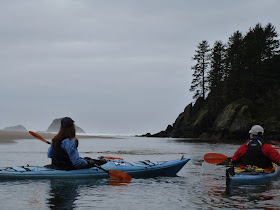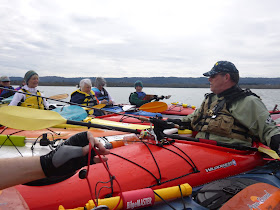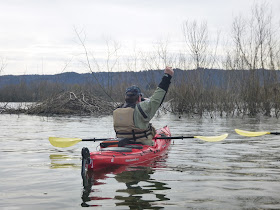Salmon River Estuary
View Larger Map
According to my extensive research
(mainly on Wikipedia) there is “absolutely nothing interesting
about the Salmon river” except that it runs past some place called
Van Duzer corridor. Named after some guy that was in office when they
needed to name stuff. There are some old trees in the
Van Duzer.
Luckily, the beauty of the actual
Estuary and Cascade Crest do not depend on any of the historic
significance (or insignificance) of the river or it drainage. Oh, and
if you go checking up on me, don't get too excited about reading how
the Salmon river starts at mount hood and is the only river whose
entire run is protected as wild and scenic river..... that is a
different Salmon River (there are 3 in the area).
So, this is what I get for trying to
throw in a little local color. Perhaps more later.
For now, lets go Kayaking.
Dammit. OK. First, lets get there.
From Portland, it is about a 2 hour
drive to Lincoln City (which is a good target if you are looking at a
map). You can spend a little more time and have more coast viewing if
you go to Tillamook and head south down the coast, but we went
through Mcminville (
past the 747 on top of the waterpark) and
then took route 18 past the Indian Casino and on down to 101.
Highway 18 is pretty much following the Salmon
River for most of the way. The river was high today. The whole area
was pretty dark and bleak looking. But the Skunk Cabbage is peaking
up yellow through the gloom and I can just taste spring there in the
running waters.
A little north jog on 101 and then down
3 rocks road to the little county park and boat ramp.
The Kayak Portland meetup organized this trip (Thanks Julie !!) and we had 10 kayakers on this
trip. I have fun just watching everyone suit up, put their gear
together, and get into the water. I think that Kayakers (and I
attempt to include myself) are all gear heads at heart.
There is so much stuff you need just to enter the water safely (at
least in the winter).
The big thing you worry about is
flipping over. Kayaks are pretty stable, but if you do something
silly (like look behind you) or you bump into someone or you run up
on a stump or you hit a wave or you miss your paddle pull or you break
to quickly into a turn or.... you have trouble getting in and out on
a high dock.... you might take a swim. In the summer, this is funny
and embarassing. In the winter, it can be deadly. Unless you have all
of the toys and training.
I have the first part of the training and most of the toys. For the training, you need to learn how to do a
“wet exit” and then how to get back into your kayak. If you are
alone, this means you need to roll out of your kayak while upside down, deploy a paddle float (blow it up and
put it on your paddle) and then use your paddle as a outrigger to
right and balance your (flooded) kayak and spin your fat ass back
into the boat. Ok, I can do that. Though I am not looking forward to
the 15 minutes it is going to take to hand pump the cockpit dry (why
does that read funny?). The real trick is the water temperature. In
the winter the water can be like 45 degrees or less and in water that
cold, it can hard to think or breath, a lot less save your ass.
And so we introduce the 2 most
important pieces of safety gear.
The first is a drysuit. A waterproof
onesy that protects you from the elements and gives you superpowers
against the cold (ok, Julie wrote that line). In one of these things
you can fall into the coldest waters (at least around here) and not
even die for like an hour. Of course, if you loose the use of your
hands, you could still be in trouble. I don't have a drysuit, but I
do have a wet suit and a good top and I have every reason to believe
that I could live in the water for 20 minutes which is long enough to
deploy the second safety piece of safety gear.
 |
| Dry Suits |
The second is your kayaking partners.
They are all trained in assisted rescue
and they should be able to come up to me, flip my boat over on top of
their boat to drain it, and then brace the kayak while I crawl back
into it. And with any luck they can have me back in the boat in less
than 10 minutes.
I would still be cold as all hell, but
should be relatively out of danger.
Wow. Ok. So. Drysuit or Wetsuit, PFD,
boots, gloves, Paddle Float, Cockpit Pump, Emergency whistle.
Check, check and check.
Oh..... CAMERA !!
Lets go kayaking!
We entered the estuary at the very end
of the low going tide and rode the current the half mile down to the
beach and the entry of the Salmon into the Pacific Ocean. The river
is flowing just about North West as it approaches the short, with a
sandbank off to the left. Then the river hits the Cascade headland
and takes a sharp hard fast left turn into the waves.

Right at this turn, the river narrows
down and the currents get strange. Lots of eddies going on, not only
with the river currents bouncing off the rocks on the bottom, but
with the wave surges coming in from the Ocean. A little exciting,
especially considering the water temperature and the afore mentioned
dying when tipped over thingee. But we weathered this storm (mainly
through enlightened self interest) and pulled our kayaks up on the
sand for a stroll on the beach. We had been warned that the tide
comes in fast and to pull our boats well up on the sand if we were
going to go exploring. So we all pulled up a good 10 feet from the
water.
And we pull out our cameras. The
headlands are just sitting there all gorgeous and such and the beach
is just begging to be photographed. So I do some of each. And then I
notice some bigger than normal waves have come over the bar and are
traveling up the river. As I watch, I realize that this wave is going
to go right past my kayak. Hell, it is going to hit my kayak. My 10
feet form the river kayak. And those of my friends too, I should add.
So I walk toward the boats, at about the same speed as the wave (not
fast at all) and between the few of us we keep the boats from getting
away. But that wave just keeps going. And I realize..... that was the
tide change. The tide is now coming in and the level of the water is
NOT going back down. Just like that. “What, haven't you ever seen a
tidal bore?” I was asked.
No. No I haven't. I used to spend my
summers running a boat dock on a tidal estuary in South Carolina.
Never saw anything like this. It was SO COOL.
 |
| Tidal Bore |
 |
| Normal Bore (LOL) |


So, we pulled our boats up another 10
feet and then took a VERY short walk.
Lets go look upriver. Once we got a
half mile up the river we were magically paddle against the current
again. Places like this you can really go up hill both ways if you
plan it right. You have to be a little careful, you can find yourself
in 3 inch water pretty fast. But that isn't all that scary. Hell, it
is even a good place to fall out. I would have, as a joke, but my
camera isn't waterproof (must fix that). One of my rules for reading
a river is that the bottom next to the bank probably looks like the
bank. So if the bank is steep too, so is the river. Look for deep
water there. If the bank is a flat mudbank..... so is the river.
We traveled up the river far enough and
then beach on the bank of a little side creek and sat in the mud and
ate our lunch. Once again the cool Drysuit kids had nothing to worry
about and just sat there in the mud and told “how warm and dry I
am” stories to their not so cool cousins. I really do find this
sort of funny. Look at some of the pictures. See all of the blue and
yellow outfits? Those are drysuits. They run like $1K a piece. They
cost on par with the kayaks. I MUST get one. I can hardly wait for my
REI rebate. At least then I will be empowered to make a choice.


After lunch, it start to rain, so we
all went back to the coast to play in the waves. Well, I went to
watch people play in the waves. The surge up the river and around the
bend was enough excitement for me. But I did get to see the other
guys do some wave practice on the little waves that come up the
river.
It was raining harder now, so we head
back to the landing.
Now, a couple of things about landings
and cameras. I have this general, until now untested, theory that it
is better to carry just a good point and shoot camera, than a less
capable but waterproof camera. So I have a nice Lumix ZS8 tucked into
my vest pocket on my PFD. If I go over, the camera is destroyed. But,
I figure I not going over unless I plan to. And when is the most
likely time to flip over? In my experience... when you get out of the
kayak at the shore.
Here is how you get out. You run up
onto the mud a little, unhitch your spray skirt, use your hands to
lift your butt up to about deck level, bend your knees and lift one
foot out and put it down in the mud. Now you can do the other foot,
and then stand up. The trick is the “lift up your butt”. At that
point your center of gravity is high and you don't have your paddle
handy for balance. A great time to flip over. Which is what I did
today at the landing. It wasn't a big deal. Except for my camera. So
instead of doing what I should have done, which was just roll out and
stand up, I caught myself on my right hand and said, “Hey, Chip,
can you come over here and rescue my camera”. I think everyone else
thought I was in trouble, which was embarrassing, but I just needed
someone to reach into my vest and grab my camera. Then I rolled out.
Water cold. Wetsuit, pretty damn good.
And no, there are no pictures, because Chip had to rescue my camera instead of unlimbering his own. Bad Choice Chip !!
Afterwards we went to the only building
in the area and had a nice dinner. Buffalo burger. Hmmm good. Or
perhaps mine was regular, the waiter wasn't sure.
Ok, enough, I need to go spend 15
minutes and hand pump the cockpit dry.













































